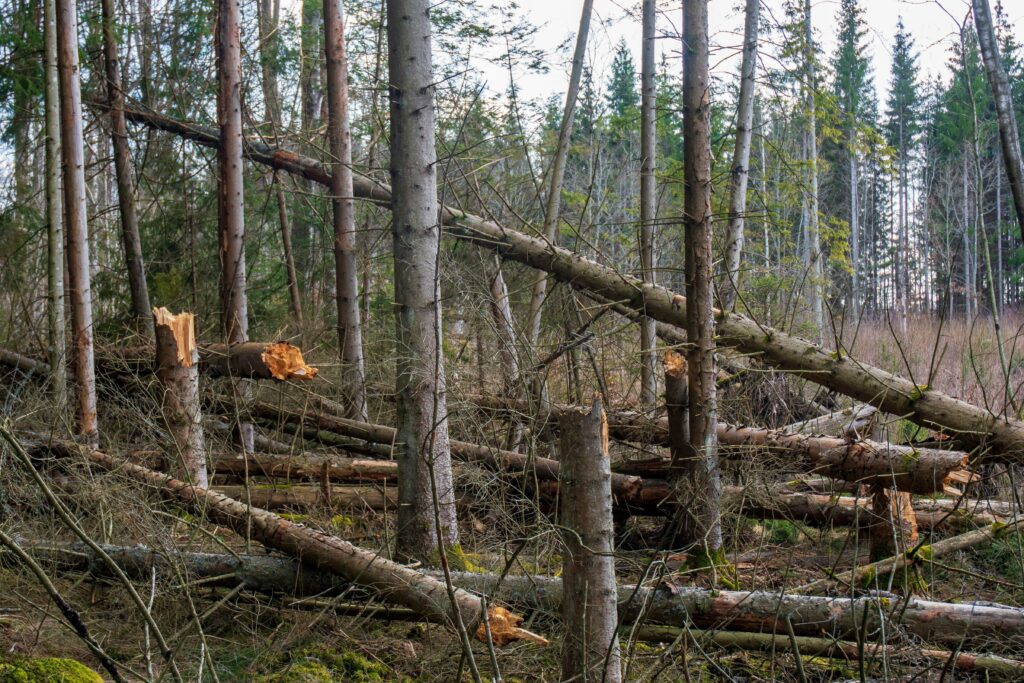If you’ve been trying to figure out how the EU Deforestation Regulation (EUDR) affects Northern Ireland, you’re not alone. The topic has caused more head-scratching than clarity among local businesses, government committees, and even regulators. Officially, the EUDR aims to stop products linked to deforestation from entering or leaving the EU market. Unofficially, it has turned into a waiting game for Northern Irish importers and exporters who sit somewhere between EU and UK trade systems.
The law itself isn’t new. The European Union passed the EUDR in June 2023, setting strict requirements for anyone placing certain commodities on the EU market. But since then, its rollout has been pushed back, debated, and dissected, especially when it comes to how it fits under the Windsor Framework.
This article breaks down what’s actually happening, why the regulation matters, how Northern Ireland fits into the puzzle, and what local businesses can do while Brussels and London finish their negotiations.
What the EUDR Is Trying to Do
The EU Deforestation Regulation (EUDR 2023/1115) targets seven commodities that contribute most to forest loss worldwide:
- Cattle
- Cocoa
- Coffee
- Palm oil
- Rubber
- Soy
- Wood
The idea is simple in theory: if these products are linked to deforestation, they shouldn’t enter the EU market. Companies must prove that their goods are “deforestation-free,” legally produced, and traceable back to the land where they originated.
To achieve that, businesses will need to collect detailed supply chain data, including geolocation coordinates for every plot of land used to produce the raw material, evidence that the land wasn’t cleared after December 31, 2020, documentation proving legal production in the source country, and a Due Diligence Statement (DDS) submitted before placing goods on the EU market.
For many European companies, that’s a tall order. For Northern Ireland, it’s a legal maze.
The Delay: What Regulation (EU) 2024/3234 Actually Changed
Originally, the EUDR was set to apply from December 30, 2024. But in December 2024, the EU quietly pushed that date back by a full year through Regulation (EU) 2024/3234.
Now the new deadlines are:
- Large and medium companies: December 30, 2025
- Small and micro enterprises (SMEs): June 30, 2026
- Country risk classification (low, standard, high risk): June 2025
The delay came after feedback from member states and industry stakeholders who warned that businesses simply weren’t ready. Setting up geolocation systems, verifying supply chains, and coordinating with overseas suppliers takes time.
From a Northern Irish perspective, that delay is a relief. It buys time for the EU and UK to decide how, or even if, the regulation will apply under the Windsor Framework. But it doesn’t change the end goal: the EUDR is still coming.

Where Technology Meets Compliance: Our Approach at EUDR.co
At EUDR.co, we’ve seen firsthand how confusing and time-consuming regulatory compliance can be, especially when the rules keep evolving. The EUDR isn’t just another piece of legislation, it’s a major shift in how supply chains are tracked, verified, and reported. Our mission is to make that process manageable for every business, whether you trade coffee, timber, soy, or packaging materials. Using a mix of satellite-based monitoring and automated reporting tools, we help companies collect reliable data, assess risk, and stay ahead of deadlines without getting buried in paperwork.
What makes our system different is its accessibility. We designed it so that companies of all sizes can use it – not just large corporations with big compliance teams. With flexible pricing and an intuitive interface, our platform lets users compile geolocation data, verify legality, and create ready-to-submit Due Diligence Statements in a fraction of the usual time. Every dataset is cross-checked for accuracy, ensuring that the reports you send to EU authorities are both compliant and dependable.
We like to think of EUDR compliance not as a legal burden but as a long-term investment in transparency and trust. By simplifying complex reporting and providing real-time sustainability insights, we help businesses turn regulation into opportunity. For Northern Irish traders in particular, where clarity around the EUDR is still unfolding, our tools provide a way to stay prepared, confident, and fully informed, no matter how the rules eventually settle.
Northern Ireland’s Position: Caught Between Two Systems
To understand the confusion, you have to look at the Windsor Framework. Under this agreement, Northern Ireland remains aligned with certain EU single-market rules to avoid a hard border on the island of Ireland. That alignment includes some product and trade regulations, but not automatically all new EU laws.
The EUDR falls into the grey area. It’s an environmental and trade regulation that hasn’t yet been formally added to the Windsor Framework. Until that happens, it technically doesn’t apply in Northern Ireland.
That hasn’t stopped local businesses from worrying. The Department of Agriculture, Environment and Rural Affairs (DAERA) has fielded multiple questions from traders trying to plan ahead. During a January 2025 committee session, DAERA officials confirmed:
- The UK Government (DEFRA) is responsible for the EUDR since it’s a trade matter.
- The EUDR has not yet been added to the Windsor Framework.
- Negotiations between the EU and UK are ongoing.
- If the EUDR is adopted, the delay regulation (2024/3234) would need to apply too, or Northern Irish businesses could face earlier compliance deadlines than the rest of the EU.
So for now, Northern Ireland is technically outside the EUDR. But few expect it to stay that way.

The Windsor Framework Angle
The Windsor Framework allows certain pieces of EU legislation to continue applying in Northern Ireland to protect frictionless trade across the Irish border. Environmental rules that affect trade in agricultural and forestry goods are among those likely to be included.
If the EUDR is eventually added, it would apply to any Northern Irish business placing relevant products on the EU market. That means manufacturers, importers, and distributors dealing in timber, leather, paper, or soy-based goods would all be affected.
The big question is timing. The UK and EU are still negotiating how the EUDR fits within the framework’s “green lane” and “red lane” trade model. Until that’s resolved, the regulation’s reach remains undefined.
Still, as one DAERA witness told the Assembly Committee, “not applying the replacement EU act would place Northern Ireland operators at a disadvantage.” In other words, if the rest of the EU benefits from the one-year delay and Northern Ireland doesn’t, local companies could face a compliance headache ahead of everyone else.
Why Businesses Should Still Prepare
Even without formal inclusion, the EUDR’s impact will spill into Northern Ireland’s economy. Here’s why it’s risky to sit back and wait:
- Cross-border trade pressure: Many Northern Irish companies trade directly with the Republic of Ireland. If Irish buyers are EUDR-compliant, they’ll expect their suppliers to meet the same standards.
- Supply chain dependency: EU-based importers will likely demand geolocation and legality data from all suppliers, including those in Northern Ireland.
- Market access risk: If NI businesses can’t provide deforestation-free documentation, they could lose contracts or face shipment delays.
- Industry alignment: The timber sector, through groups like Timber Development UK (TDUK), is already advising members to prepare now, assuming EUDR will apply by late 2025.
The message is consistent: start collecting supply chain data and get familiar with the TRACES system (the EU’s online portal for submitting Due Diligence Statements).
What the Regulation Requires in Practice
If and when the EUDR takes effect in Northern Ireland, businesses will have to meet several practical requirements that go far beyond simple paperwork. Compliance isn’t just about filling in a form; it’s about building systems that can prove exactly where a product comes from, how it was made, and that it didn’t contribute to deforestation. Here’s what that looks like in practice:
1. Supply Chain Mapping
Companies will need a full picture of where their raw materials originate. That means collecting geolocation data for every farm, forest, or plantation that supplies them. For large or complex supply chains, a single GPS point isn’t enough. The EU requires polygon mapping, which outlines the exact boundaries of each land parcel. This step is one of the biggest challenges, especially for businesses sourcing from regions where land ownership records are incomplete or inconsistent.
2. Legal Production Verification
Businesses must confirm that every stage of production complies with local laws in the country of origin. That includes environmental regulations, labor protections, and human rights standards. Essentially, the product’s entire supply chain must be legally sound, and the documentation must prove it. Companies will need to work closely with suppliers to gather official permits, certifications, or government records to back up their claims.
3. Deforestation-Free Proof
This is the heart of the EUDR. Operators must provide evidence that no deforestation or forest degradation occurred on the land where their materials were produced after December 31, 2020. In many cases, that will mean relying on satellite imagery, government data, or third-party audits. It’s not enough for suppliers to make verbal assurances; they’ll need verifiable proof backed by location data and time-stamped records.
4. Risk Assessment
Before goods can be placed on the EU market, companies must assess how likely it is that their supply chain contributes to deforestation. That means reviewing country risk classifications (low, standard, or high risk), analyzing sourcing regions, and flagging any potential red zones near protected areas or indigenous lands. The assessment has to be documented and updated regularly to show ongoing monitoring.
5. Due Diligence Statement (DDS)
Every shipment covered by the EUDR requires a Due Diligence Statement that confirms compliance. This statement must be submitted through the EU’s TRACES platform, which acts as the central database for enforcement authorities across all member states. The DDS isn’t just a formality; it’s a legally binding declaration. Submitting false or incomplete information could trigger investigations, penalties, or trade restrictions.
6. Record-Keeping
All compliance records, including risk assessments, supplier documents, and satellite data, must be stored for at least five years. These records should be organized and ready to present to regulators if requested. For many companies, this will mean developing internal systems or digital databases to manage large volumes of data securely.
For small traders and family-run businesses, this is no small task. The administrative load can feel overwhelming, especially for those who rely on multiple small suppliers or have limited digital systems in place. Yet, the penalties for non-compliance are severe and not worth the risk.
Failing to meet the EUDR requirements could result in:
- Fines of up to 4% of annual turnover
- Seizure or destruction of goods found to be non-compliant
- Temporary exclusion from EU markets
- Potential criminal liability for company directors
While the process might sound demanding, early preparation will make a huge difference. Businesses that start mapping supply chains and building compliance systems now will be in a far stronger position once enforcement begins.

What the Assembly Discussion Revealed
The January 2025 committee session at Stormont provided rare clarity on the government’s position. DAERA officials confirmed that while Northern Ireland is not yet bound by the EUDR, the department expects eventual alignment once the Windsor Framework discussions conclude.
During the discussion, officials explained that DEFRA currently leads EUDR policy at the UK level, while DAERA’s role is to act as a liaison for Northern Irish stakeholders. The department does not have the authority to set or modify EUDR rules but continues to communicate local concerns to Westminster and Brussels. They also emphasized that businesses should not assume they are exempt, since alignment with the regulation remains likely. The 12-month delay to December 2025, officials said, gives everyone valuable breathing space to clarify how compliance will ultimately work.
Committee members from multiple parties expressed frustration about the ongoing uncertainty. Many noted that Northern Irish businesses are already managing extra paperwork under post-Brexit arrangements, and further regulatory ambiguity adds to the pressure. Despite this, most agreed that delaying the EUDR’s start date was a practical and necessary step. In the end, it was one of those rare committee meetings that ended in agreement: the EUDR is coming, just not as quickly as anyone first expected.
The Bigger Picture: Why It Matters
It’s tempting to see the EUDR as just another regulatory headache. But the reality is bigger than compliance paperwork. This regulation reflects a fundamental shift in how global trade links to environmental accountability.
For decades, companies could rely on legality as their safety net—if local laws allowed a forest to be cleared, the products from it could enter the global market. The EUDR flips that logic. It demands proof that production didn’t harm forests, even if it was technically legal where it happened.
That’s a major philosophical shift, one that could push better land-use practices worldwide.
For Northern Ireland, it’s also a chance to align with growing sustainability standards that will soon define market access, not just in Europe but globally.
What Northern Irish Businesses Can Do Right Now
Until the Windsor Framework decision is finalized, the best approach is to prepare, not pause. The EUDR may not yet be written into Northern Ireland’s legal framework, but the direction of travel is obvious. Companies that wait for an official announcement risk finding themselves short on time once implementation begins. The groundwork you lay now: mapping your suppliers, gathering data, and training your staff, will save months of stress later.
Here’s a short checklist for getting ready:
1. Map Your Supply Chain
Identify every tier of supplier that provides EUDR-covered commodities or products. Even if you only buy from one local distributor, it’s worth asking where their materials come from. Full visibility is the first step toward compliance.
2. Gather Origin Data
Ask for geolocation coordinates, land-use history, and legal compliance proof for all raw materials. Don’t assume your suppliers have this information ready, many will be learning alongside you. Start the conversation early to avoid bottlenecks later.
3. Track Packaging Materials
If you use wood pulp or paper, confirm whether they’re 100% recycled or require due diligence. Packaging often gets overlooked, but under the EUDR, it’s treated just like the product itself.
4. Test Digital Systems
Explore traceability software or start using TRACES to understand how submission works. The sooner you familiarize yourself with these platforms, the smoother the transition will be when reporting becomes mandatory.
5. Monitor Updates from DEFRA, DAERA, and Trade Associations
Keep an eye on official announcements and industry webinars throughout 2025. These updates often contain subtle but important changes to compliance expectations and risk classifications.
6. Train Your Teams
Compliance won’t just sit with management. Procurement, logistics, and sustainability staff will all play a role. Make sure everyone understands what data needs to be collected, how it should be stored, and why accuracy matters.
The most successful companies won’t be the ones that wait for certainty—they’ll be the ones that build systems now, adapt early, and treat EUDR compliance as part of doing responsible business rather than a last-minute hurdle.

Looking Ahead: 2025 and Beyond
Here’s the reality: even if Northern Ireland’s inclusion takes longer than expected, the direction of travel is obvious. The EUDR reflects a broader global move toward supply chain transparency and sustainability.
Whether it’s EU legislation, UK mirror laws, or voluntary ESG standards, businesses will increasingly need to prove where their products come from and how they were made.
The delay gives Northern Irish firms a valuable window to modernize systems, talk to suppliers, and turn compliance into an advantage rather than a scramble.
If the regulation lands in 2025, those who’ve already mapped their supply chains will be fine. Those who wait for official word may find themselves rushing against the clock.
Final Thoughts
The EUDR may be delayed, but it isn’t going away. Northern Ireland finds itself in an awkward middle ground, technically outside the law for now, but likely inside it soon.
The smart move is to treat the next year as preparation time. Use it to understand your supply chain, collect the right data, and test digital compliance tools. Because once the Windsor Framework decision lands, the transition will happen quickly.
In short: it’s delayed, it’s unclear, but it’s still coming. And when it does, those who prepared early will be glad they didn’t wait for the paperwork to catch up.
Frequently Asked Questions (FAQ)
1. Does the EUDR apply to Northern Ireland?
Not yet. The regulation has not been formally added to the Windsor Framework, which governs EU-related trade rules in Northern Ireland. However, discussions between the UK Government and the EU are ongoing, and alignment is widely expected in the future. Businesses are being advised to prepare as though the EUDR will eventually apply.
2. Why was the EUDR delayed?
The European Commission postponed the enforcement date by 12 months to give governments, companies, and supply chains more time to prepare. Large and medium-sized enterprises must comply by December 30, 2025, while SMEs have until June 30, 2026. The delay was formalized through Regulation (EU) 2024/3234.
3. What will Northern Irish businesses need to do once it applies?
Companies will need to map their supply chains, collect geolocation data, verify that raw materials weren’t linked to deforestation, and submit Due Diligence Statements through the EU’s TRACES system. They’ll also need to keep records for at least five years in case of inspections or audits.
4. What happens if a business fails to comply?
Non-compliance can lead to fines of up to 4% of annual turnover, seizure of goods, suspension from EU markets, and even potential criminal liability for company directors. The EUDR carries strict penalties to ensure supply chain accountability.


